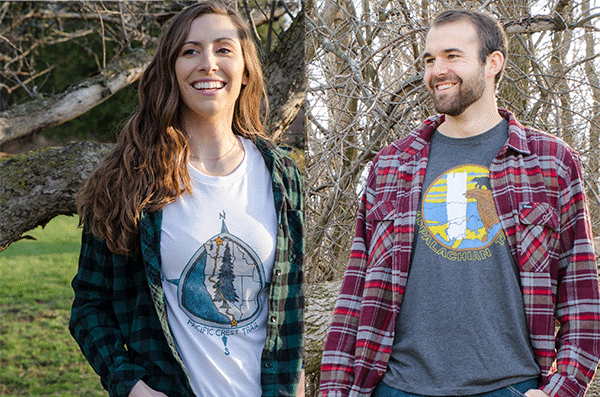We got a bit in the weeds on this piece, but it’s important for us to share WHY we use responsible fabrics like rPET. In an ideal world, single use plastic would no longer be available. However, while they are still around, this is a great solution to recycled and reuse them. Big thanks to iDiveblue for collaborating!
Author: Pippa Strickland
Recycling is nothing new, with evidence from ancient waste dumps indicating that humans were recycling as far back as the fourth century BC. Scrap bronze and metals were collected throughout Europe and melted down for reuse prior to the Industrial Revolution while beverage bottles were recycled by some drink manufacturers as early as 1800.
But the surge in plastic production following World War II has given recycling new importance, with plastic waste accumulating in landfills, littering our landscapes, and being washed into our oceans. Single-use plastics such as drink bottles and takeaway containers have been the “pinups” of the problem but waste from the fashion industry is also a significant contributor.
More than 60% of fabric fibers are now made from fossil fuel-derived synthetics, meaning that once they end up in landfills, they will not decay. It’s been estimated that around 10,000 items of clothing are being sent to landfill every five minutes, with around 85% of textile waste in the United States ending up in landfills, incinerated or washed into the ocean as synthetic microfibers.
The results have been devastating, with toxic chemicals being leached into our soils and marine life killed as they struggle to compete against our plastic addiction. Initiatives such as the Ocean Cleanup and 4Ocean have played a vital role in removing plastic waste from our ocean, but recycling provides an effective way of preventing plastics from ending up there in the first place.
Discarded plastic can be used to create recycled PET or rPET and given a new lease of life as clothing, shoes, and bags. It’s an industry that’s still in its early years but is gaining momentum as consumers become aware of the negative impacts of fast fashion and the resource requirements for manufacturing clothing from scratch.
So, what exactly is rPET and how can it be transformed into sustainable clothing that you can wear with pride?
What is PET?
PET stands for Polyethylene Terephthalate, a thermoplastic polymer of ethylene glycol and terephthalic acid that’s renowned for its mechanical, thermal, and chemical resistance. Also known as polyester, it’s the most common type of plastic resin, favored for its strong and lightweight properties. Chances are the peanut butter in your cupboard or the cleaning solution for your laundry is in a bottle made from PET.
While PET is widespread, it’s also easily recyclable and can be converted into everything from backpacks to shoes, sleeping bags, and clothing. PET bottles are instantly recognizable thanks to their “#1” recycling label and are accepted by most recycling plants in the United States. When recycled correctly, excessive amounts of plastic are prevented from ending up in landfills or breaking down into microplastic pieces that are devastating for our oceans.
In recycling facilities, plastic bottles can be mechanically broken down into tiny flakes, which are then melted and spun into yarn. This is then woven into a recycled fabric that can be used to create sustainable products. It takes around 10 bottles to create a new T-shirt, 63 bottles for a sweater, or 114 bottles to insulate a sleeping bag.
The manufacturing of rPET fabrics reduces the need to create new polyester textiles to satisfy the insatiable demands of the fashion industry. While it does take energy and water to recycle plastics into new forms, including clothing, it takes significantly less energy (up to 85% less) than manufacturing them from scratch. This results in less extraction of oil and natural gases, as well as less carbon being emitted during the production process.
rPET fabrics are not only a sustainable option but start the conversation about where our clothing is coming from and the impact our consumer fashion choices are having on the environment.
What can you do?
Aside from purchasing sustainably produced rPET products, it’s essential that we all play our part by recycling all recyclable products. Despite everything we know about the detrimental effects of plastic waste, less than half of plastic bottles purchased each year end up in recycling facilities. Of those that are recycled, only around 7% are transformed into new bottles.
Check your local guidelines about what can and can’t be put in your recycling bins to avoid anything unnecessarily ending up in landfills. When plastics end up in landfills, they take thousands of years to break down, all the while leaching toxic chemicals into the subsoil and groundwater reserves.
Whenever possible, look for alternatives to single-use plastics, such as straws made out of steel, glass, biodegradable plastic, or bamboo. There are so many exciting innovations taking place in the alternative plastic industry, with everything from corn to mycelium and the byproduct of sugarcane processing being transformed into compostable and biodegradable containers.
Purchasing rPET products is a great way of supporting the market for recycled plastics, which is essential for recycling facilities to stay in business. If there’s no profit in collecting, sorting, and recycling materials, then they’re likely to close their doors. When you support businesses that are promoting sustainability, it also sends a strong message to companies who aren’t that they need to up their game!



